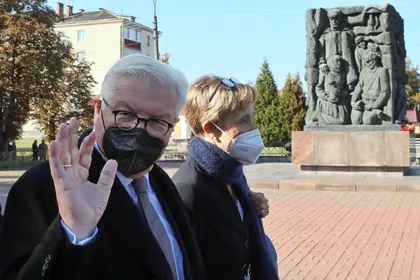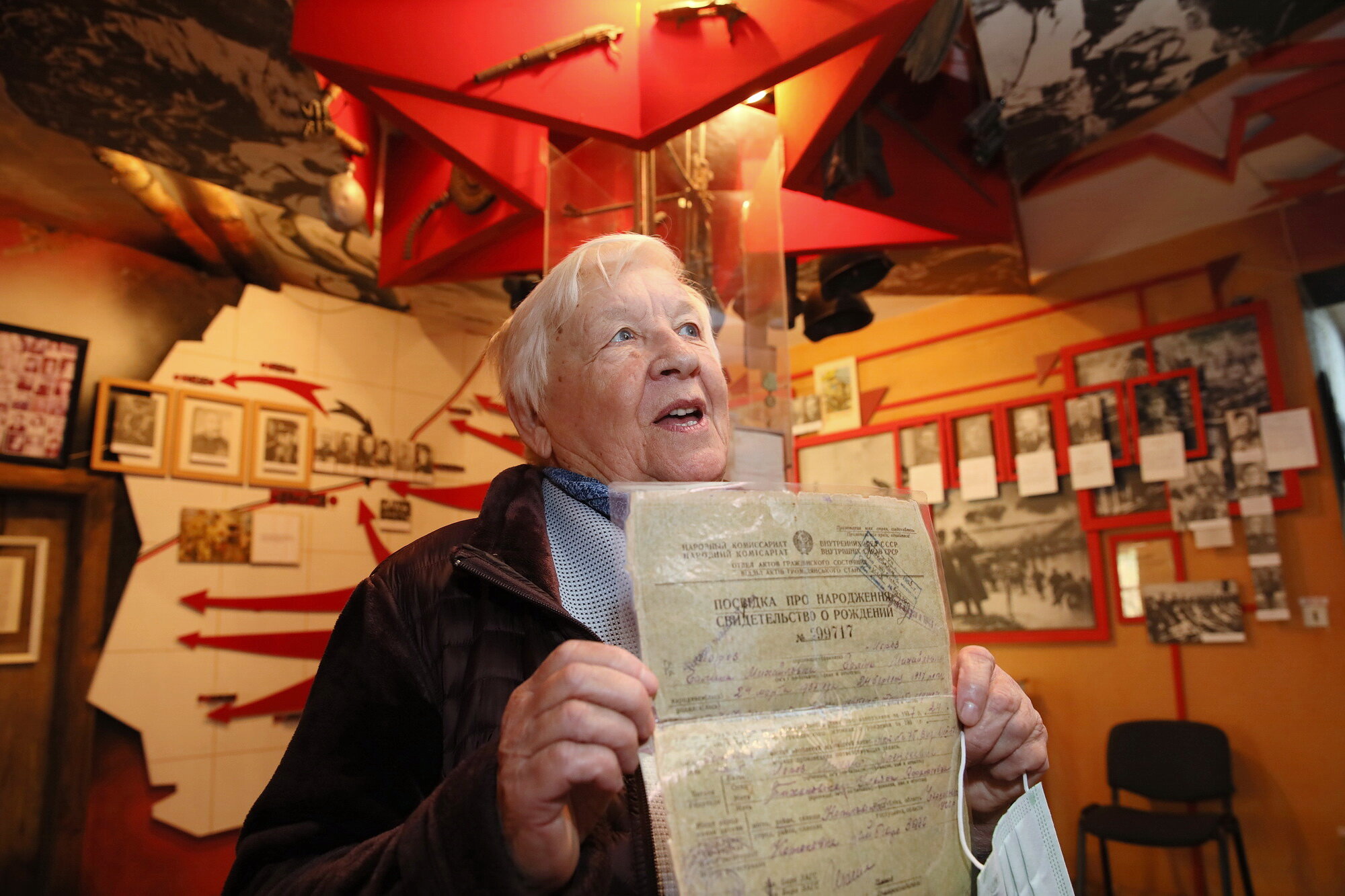KORIUKIVKA, Ukraine — This Chernihiv Oblast town got a rare visit from German President Frank-Walter Steinmeier on Oct. 6.
Unfortunately, the event that brought Steinmeier to Koriukivka, home to 12,500 people located 290 kilometers northeast of Kyiv, was grim.
JOIN US ON TELEGRAM
Follow our coverage of the war on the @Kyivpost_official.
In March 1943, German-Hungarian troops, assisted by local collaborators, murdered over 6,700 local residents and burned Koriukivka to the ground, a horrendous war crime that still haunts the town today.
“It’s the deadliest reprisal raid during World War II,” Andriy Naymenko, acting head of the local museum, told the Kyiv Post. “The event is largely unknown to the wider public.”
Steinmeier’s visit to this place of thick woods and deep swamps was meant to raise the visibility of Nazi crimes.
A German-funded project is set to shed light on the largely forgotten massacre. The joint German-Ukrainian-Hungarian project will document the testimonies of witnesses and their family members, dig deep into the archives and publish documents to better explain what happened over 78 years ago.
Koriukivka is expected to receive a new memorial site, something that the town has long desired.
“It’s crucial to remember what happened, we are trying to fill in the blind spots and we should work together,” Steinmeier told local high school students gathered for a 40-minute discussion with the president.
Massacre memories
Retiree Halyna Popova, 84, has horrific scenes from the massacre engraved in her memory.
Popova was only five when, on March 2, 1943, additional German troops began entering the city. A day earlier, German and Hungarian troops began executing residents in the main restaurant near the city center.
“We lived on the far side of Koriukivka, and my mom was walking across the town to the library where she worked,” Popova recalled. “She saw military trucks entering the city, she knew that something was about to happen.”
Popova’s grandparents lived on the same street bearing the name of famous Ukrainian poet Taras Shevchenko. Popova recalled that her grandparents didn’t want to leave their house, citing age and the need to look after cattle.
Popova’s mom rushed back to the house hiding Halyna and her three siblings in the snow behind the barn.
Popova recalled that many residents didn’t leave the town and stayed put even after the first executions occurred.
Popova said that she saw her elderly neighbors being shot by Nazis and their allies. Her grandparents also perished.
After executing civilians, the perpetrators began setting houses on fire.
According to Popova, their hideout was uncovered by a Nazi collaborator who spoke Russian, yet he allowed Halyna, her siblings and her mom to flee. Halyna and her family found refuge in a neighbor’s basement where dozens of people were crammed, fearing for their lives.
The Nazis “saw that there were people in the basement, but everything around was on fire, so they didn’t risk approaching,” Popova said. “We sat there till sundown lacking fresh air to breathe, when we left the basement, the whole town was gone.”
Naymenko said that since most houses had hay rooftops, the fire quickly destroyed the town. “Only about 10 buildings withstood the fire,” he said.
According to Naymenko, the massacre was conducted by Hungarian troops stationed in Koriukivka under the command of Zoltan Algya-Pap. They were assisted by Nazi German troops from nearby Snovsk and collaborators drawn from war prisoners.
Historians agree that the massacre was committed as a reprisal for a guerrilla raid on a local prison in which many German soldiers were killed.
“In late February guerrilla fighters attacked a prison to free their relatives, the German garrison together with the local police was partially destroyed,” Naymenko said.
In 1947, 13 Hungarians and three Germans were prosecuted in Chernihiv, among them was Algya-Pap and Bruno Frantz Bayer, the German military commander who oversaw the massacre.
“They were all sentenced to 25 years in prison,” Naymenko said. “In 1955, Algya-Pap was handed over to Hungary where he was eventually released. He lived a long life, later becoming a Catholic priest.”
Poster town
Despite its horrendous past, Koriukivka is presentable today. Over the past three years, the town saw substantial investments from the Ukrainian government.
President Volodymyr Zelensky’s road construction project has reached Chernihiv Oblast, tying Koriukivka to the provincial capital with fresh asphalt.
The town itself has new roads with clean sidewalks and bike lanes that are packed with people traveling through the city.
The city’s main school was renovated for $3 million, adding a new façade, modern classrooms and bicycle parking spots.
Today, only an old Soviet monument honoring “the sacrifice of Koriukivka residents in 1941–1943” hints that the town was a site of massive casualties during World War II.
The city was ready to welcome the German delegation, which also included German Ambassador to Ukraine Anka Feldhusen, journalists and historians involved in the historiographic project about the Koriukivka massacre.
“This is the most significant visit to Koriukivka since Ukrainian independence,” said Mayor Ratan Akhmedov.
Finding truth
Germany has invested time and money in finding the truth about Koriukivka.
“I think there’s a lack of understanding of the extent of man’s crimes committed then, especially in Ukraine, and we need to bring memory to those events,” said professor Tanja Penter, who was part of the German delegation.
Olena Lysenko, a member of the National Academy of Sciences of Ukraine, said that the tragedy was deliberately muted by the Soviet Union. In her opinion, it was because of the role of Ukrainian guerrilla fighters, known as partisans.
“The victims aren’t properly commemorated, because there were never any concrete studies about this event due to the tabooing of this topic during the Soviet times,” Lysenko said.
Naymenko agreed, saying that guerrilla fighters under the command of Major-General Oleksiy Fedorov outnumbered German-Hungarian forces in Koriukivka and could have prevented the massacre.
But “they were preparing for their Volyn raid and didn’t want to spend ammunition,” he said.
According to Lysenko, historians want to gather all existing evidence of those events and publish a concrete account of what happened. Today, only a quarter of those killed in the massacre are identified, with more than 5,000 victims lacking proper burials.
The project is set to be finished in December 2022.
Local authorities have been vocal in their desire to see a memorial dedicated to the event that shaped the town’s history.
The Germans are eager to assist.
“The president wanted to focus our attention to the forgotten places where Nazis committed crimes to make sure that these atrocities will never happen again,” Feldhusen said.
You can also highlight the text and press Ctrl + Enter






